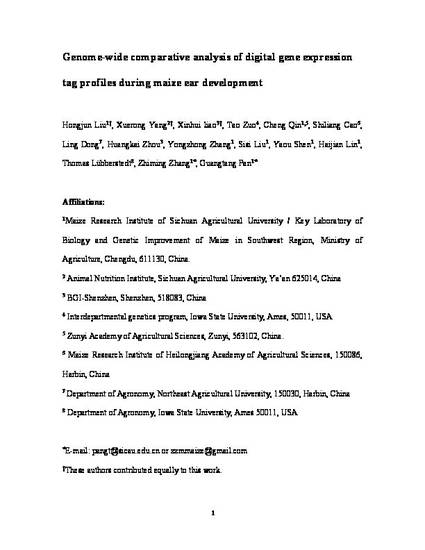
Background: Development of the maize (Zea mays L.) female inflorescence (ear) has an important impact on corn yield. However, the molecular mechanisms underlying maize ear development are poorly understood.
Results: We profiled and analyzed gene expression of the maize ear at four developmental stages: elongation phase (I), spikelet differentiation phase (II), floret primordium differentiation phase (III), and floret organ differentiation phase (IV). Based on genome-wide profile analysis, we detected differential mRNA of maize genes. Among the ~6,800 differentially expressed genes (DEGs), 3,325 genes were differentially expressed in stage II, 3,765 genes in III, and 1,698 genes in IV, compared to its previous adjacent stages, respectively. Furthermore, some of DEGs were predicted to be potential candidates in maize ear development, such as AGAMOUS (GRMZM2G052890) and ATFP3 (GRMZM2G155281). Meanwhile, some genes were well-known annotated to the mutants during maize inflorescence development such as compact plant2 (ct2), zea AGAMOUS homolog1 (zag1), bearded ear (bde), and silky1 (si1). Some DEGs were predicted targets of microRNAs such as microRNA156. K-means clustering revealed that the DEGs showed 18 major expression patterns. Thirteen transcriptional factors from 10 families were differentially expressed across three comparisons of adjacent stages (II vs. I, III vs. II, IV vs. III). Antisense transcripts were widespread during all four stages, and might play important roles in maize ear development. Finally, we randomly selected 32 DEGs to validate their expression patterns using quantitative reverse-transcription polymerase chain reaction (qRT-PCR). The results were consistent with those from Solexa sequencing.
Conclusions: DEGs technique had shown an advantage in detecting candidates, and some transcription factors during maize ear development. RT-PCR data were consistent with our sequencing data and supplied additional information on ear developmental processes. These results provide a molecular foundation for future research on maize ear development.
Available at: http://works.bepress.com/thomas-lubberstedt/65/

This is a manuscript of an article published as Liu, Hongjun, Xuerong Yang, Xinhui Liao, Tao Zuo, Cheng Qin, Shiliang Cao, Ling Dong et al. "Genome-wide comparative analysis of digital gene expression tag profiles during maize ear development." Genomics 106, no. 1 (2015): 52-60. doi: 10.1016/j.ygeno.2015.03.005. Posted with permission.